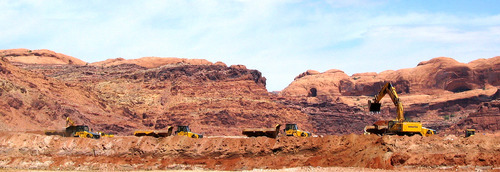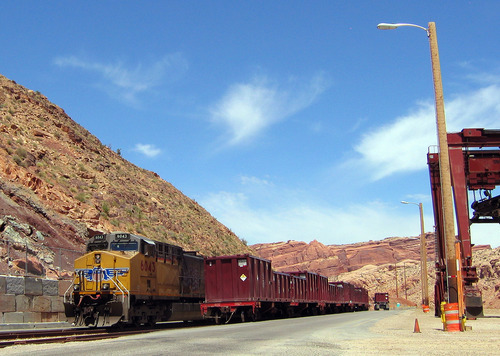This is an archived article that was published on sltrib.com in 2011, and information in the article may be outdated. It is provided only for personal research purposes and may not be reprinted.
Moab • Cleanup of the massive uranium-waste pile here has been humming along at what some would describe as lightning speed.
In two years, the Department of Energy has hauled away nearly 4 million tons of uranium tailings, which for decades had been leaching into the adjacent Colorado River. The work is about two years ahead of schedule, and makes DOE project manager Don Metzler burst with pride.
"Look!" he exclaimed, gazing over the deep gouge excavators have carved into the 130-acre pile. "This pile is disappearing."
Now, with another 12 million tons still to go, the American Recovery and Reinvestment Act money that has fueled the accelerated cleanup is about to run out. Progress is expected to slow to a comparative crawl as the Energy Department slashes the cleanup team by two-thirds next month.
Instead of 320 people on the job, there will be funding enough for around 100 under the DOE's projected budget for cleaning up the old uranium mill started by Charlie Steen and later taken on by the bankrupt Atlas Corp.
Congress gave $6 billion in stimulus money to the Energy Department two years ago. And the DOE pumped $104 million of that into moving the tailings from the mill site, which is across the two-lane State Road 161 from Arches National Park, and another $4 million for other cleanup work there.
The cash infusion made it possible to run two, 88-car trainloads of waste a day up to the Crescent Junction disposal site about 32 miles north of the pile. With the stimulus program scheduled to run out next month, Metzler expects to run one trainload a day four days a week.
For many who advocated removing the tailings, the spending has gone a long way already to eliminate the ammonia, sulfuric acid, uranium and other contaminants in the tailings to make the picture-postcard place not only cleaner but safer.
No more ammonia killing endangered fish. No more risk of uranium waste sloughing into a river that 30 million people use for drinking water.
"Here is a project," said Metzler, "where taxpayers got every dollar's worth."
Ken Davey, Moab's economic development director, said the local impact will be significant, since most of the cleanup's well-paying jobs have been filled by people in Grand County and other nearby communities.
"The cutbacks are going to affect us," he said of the imminent layoffs. "We're going to take an economic hit in this community."
Local officials have written to members of Congress to point out how important the project has been and to urge their continued support even with all the talk about cutting the federal budget.
"We are hoping the social and long-term benefits [of the cleanup] are kept in mind," Davey said.
Last week, U.S. Rep. Jim Matheson prodded Energy Secretary Stephen Chu about the cleanup schedule. The Utah Democrat pointed out the DOE doesn't expect to finish removing the pile and reclaim the site until 2025, even though Congress set a deadline of 2019.
The congressman asked what the Energy Department is doing to meet that schedule.
He also asked Chu if the rebidding of the cleanup contract now under way — carried out so far by Salt Lake City-based EnergySolutions Inc. — might cause any delays. The new contract would cover the next five years.
"I look forward to working with you to ensure that the tailings removal in Moab is carried out in a safe, environmentally sound and timely manner," Matheson said in his May 5 letter.
Previously, Matheson has said $70 million to $90 million is needed in the next budget year to stay on track.
Back at the pile, Metzler has been writing recommendations for the crew members who have already begun to look for work and coordinating with the local Workforce Services office about possible jobs at an upcoming road-widening project.
He's also looking ahead toward the completion's cleanup, whenever that ultimately happens.
"The quicker we get it done," he said, "the cheaper it is for the taxpayer."
Tailings cleanup
R The Atlas uranium mill, opened in 1955, generated 1,000 tons of tailings a day. DOE has been hauling away about 10,000 tons each day for the past two years.







